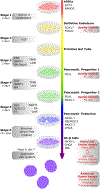Generation of insulin-producing pancreatic β cells from multiple human stem cell lines
- PMID: 34349281
- PMCID: PMC8529911
- DOI: 10.1038/s41596-021-00560-y
Generation of insulin-producing pancreatic β cells from multiple human stem cell lines
Abstract
We detail a six-stage planar differentiation methodology for generating human pluripotent stem cell-derived pancreatic β cells (SC-β cells) that secrete high amounts of insulin in response to glucose stimulation. This protocol first induces definitive endoderm by treatment with Activin A and CHIR99021, then generates PDX1+/NKX6-1+ pancreatic progenitors through the timed application of keratinocyte growth factor, SANT1, TPPB, LDN193189 and retinoic acid. Endocrine induction and subsequent SC-β-cell specification is achieved with a cocktail consisting of the cytoskeletal depolymerizing compound latrunculin A combined with XXI, T3, ALK5 inhibitor II, SANT1 and retinoic acid. The resulting SC-β cells and other endocrine cell types can then be aggregated into islet-like clusters for analysis and transplantation. This differentiation methodology takes ~34 d to generate functional SC-β cells, plus an additional 1-2 weeks for initial stem cell expansion and final cell assessment. This protocol builds upon a large body of previous work for generating β-like cells. In this iteration, we have eliminated the need for 3D culture during endocrine induction, allowing for the generation of highly functional SC-β cells to be done entirely on tissue culture polystyrene. This change simplifies the differentiation methodology, requiring only basic stem cell culture experience as well as familiarity with assessment techniques common in biology laboratories. In addition to expanding protocol accessibility and simplifying SC-β-cell generation, we demonstrate that this planar methodology is amenable for differentiating SC-β cells from a wide variety of cell lines from various sources, broadening its applicability.
© 2021. The Author(s), under exclusive licence to Springer Nature Limited.
Conflict of interest statement
COMPETING INTERESTS
N.J.H. and J.R.M. are inventors on patents and patent applications related to the SC-β cell differentiation protocol described in this manuscript.
Figures






References
-
- Brennan DC, Kopetskie HA & Sayre PH Long-term follow-up of the Edmonton protocol of islet transplantation in the United States. Am. J. Transplant 16, 509–17 (2016). - PubMed
-
- Shapiro J et al. Islet transplantation in seven patients with type 1 diabetes mellitus using a glucocorticoid-free immunosuppressive regimen. New. Engl. J. Med 343, 230–38 (2000). - PubMed
-
- D’Amour KA et al. Efficient differentiation of human embryonic stem cells to definitive endoderm. Nat. Biotechnol 23, 1534–41 (2005). - PubMed
-
- D’Amour KA et al. Production of pancreatic hormone-expressing endocrine cells from human embryonic stem cells. Nat. Biotechnol 24, 1392–1401 (2006). - PubMed
Key references using this protocol
Publication types
MeSH terms
Grants and funding
LinkOut - more resources
Full Text Sources
Other Literature Sources

